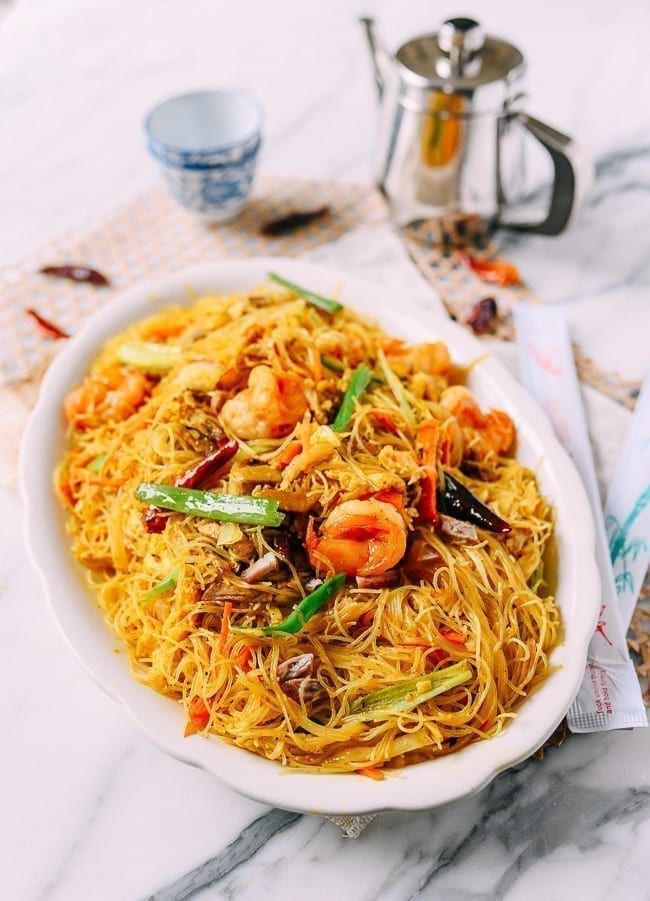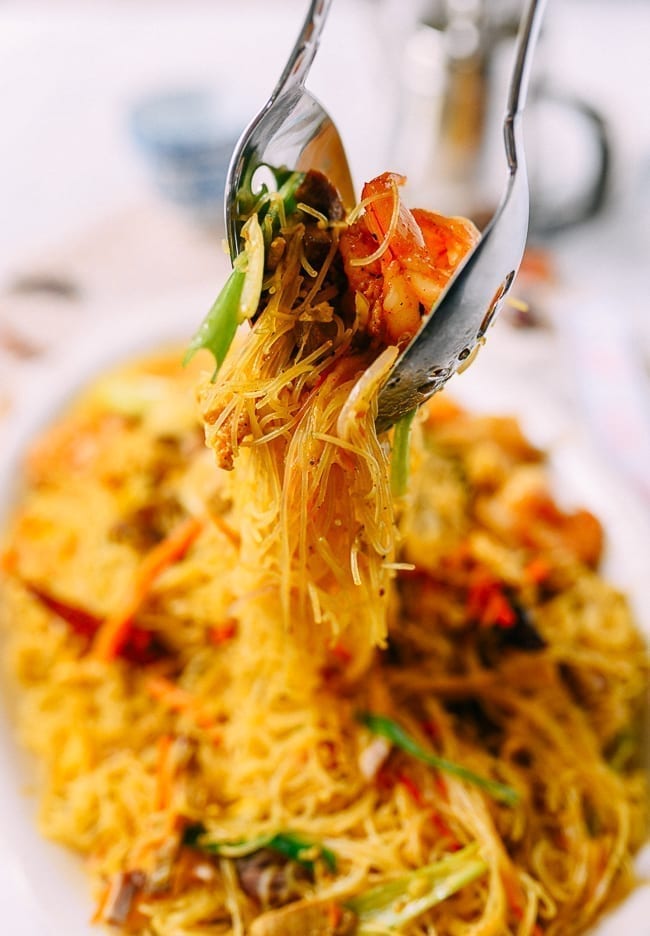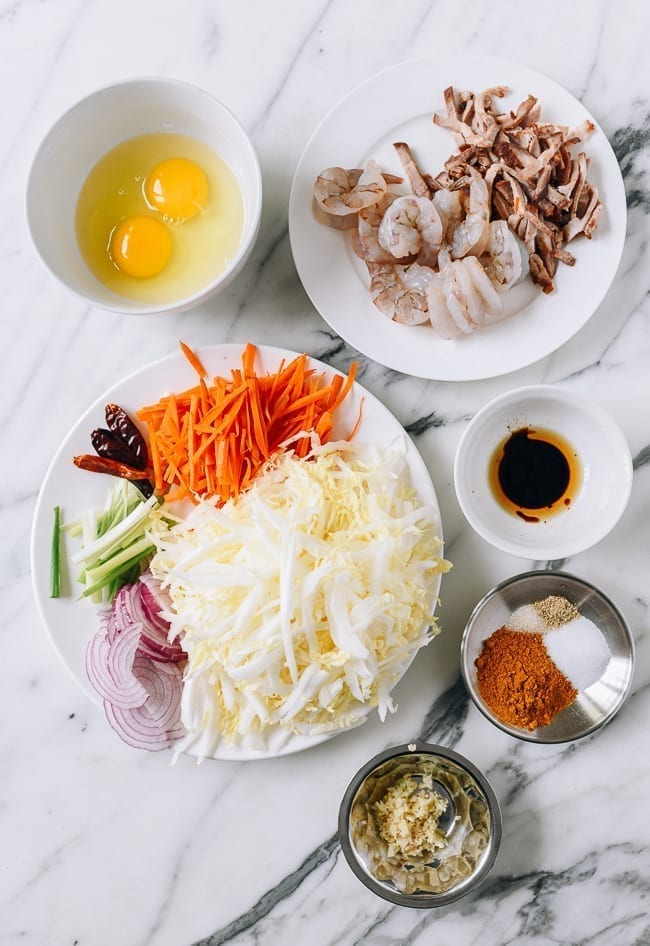Our Singapore Noodles recipe tastes just like what you’d get at any Chinese takeout or Cantonese restaurant (or maybe better).
This updated version of our original recipe (published 11/4/13) includes more detailed instructions as well as recipe improvements and a video—be sure to check it out after the step-by-step photos!
We hope you give it a try and enjoy this iconic dish!
If you’re not into curry, though, check out our Xiamen Chow Mei Fun recipe. It’s a similar dish without the curry powder! If you’re looking for a vegetarian version of this dish, check out our Vegetarian Singapore Noodles recipe.
MORE CHINESE AMERICAN THAN SINGAPOREAN
One of the most popular dishes on any Chinese take-out menu is Singapore Noodles, or Singapore Mei Fun, sometimes spelled Singapore Mai Fun. It’s certainly a must-order for our family anytime we order Chinese takeout.
Now, we’ve met people from Singapore who are pretty bewildered when they come to the U.S. and see their country’s moniker attached to this dish of noodles and curry powder. We have also seen many comments on our blog with the same kind of commentary.
I’m not entirely sure what makes it Singaporean, just like I’m not sure what makes an egg roll Chinese. But as with many items on a Chinese takeout menu, despite its fuzzy origins, it’s still delicious.
The ingredients (curry powder, rice noodles, ham, napa cabbage, etc.) aren’t as difficult to find in grocery stores these days. If you have a Chinese market near you, even better!
IS ROAST PORK, HAM OR CHINESE SAUSAGE TRADITIONAL?
The protein you decide to use will depend on personal preference, availability, and perhaps what the chef’s preference is as the restaurant you frequent.
We find that most restaurants use julienned Chinese roast pork, char siu. These restaurants usually also offer roast pork on their menu. If you’re like many of our readers who’ve already tried our char siu recipe and keep some in the freezer for uses like this, you’re already set!
Virginia ham from the deli counter is also a good choice since it’s super convenient. You seldom see it in restaurant versions, however.
Lastly, you could use Chinese sausage. It’s not as common, but if you have it on hand and enjoy it, go for it! When we photographed this recipe, we used char siu, and we used ham when we filmed the video.
WHAT VEGETABLES ARE USED FOR SINGAPORE NOODLES?
Commonly used vegetables in Singapore Noodles include carrots, napa cabbage or regular cabbage, onions, and scallions. Some versions have very few vegetables, if any.
We went a traditional route with this recipe, but you can change it up and add other ingredients like celery, bean sprouts, mushrooms, bell peppers, or anything else in the fridge. If you want the familiar dish you get from restaurants, though, stick to our ingredients.
Just make sure you take the time to julienne the napa cabbage, carrot, and scallions, and to thinly slice the red onion.
All the vegetables should be cut into approximately the same shape. This is a noodle dish, so everything (except the shrimp of course) must be in thin strips to match the shape of the noodles.
HOW TO PREPARE DRIED RICE NOODLES
The type of rice noodles you use for this Singapore Noodles recipe is very important!
You must use thin vermicelli rice noodles. Make sure they’re not mung bean vermicelli, which are clear, while the rice noodles are more opaque.
Depending upon brand of rice noodles you buy, soaking times may vary. However, how you soak the noodles makes a huge difference in the dish:
- Cold Overnight Soak: Soaking dried rice noodles in cold water overnight allows them to rehydrate gradually and will yield a softer texture in the finished dish. This is the preferred method, if you can remember to do it!
- 30 Minute Hot Water Soak: Soaking the noodles in hot tap water for at least 30 minutes also does the job, but the noodles may end up a bit more “al dente” in the finished dish.
- Boiling: You can also cook the noodles in boiling water for about 1 minute, but pay attention to package directions before deciding whether to use this method, as it’s easy to overcook them.
- After you make these noodles once, you can make adjustments for the next time, including exploring other brands of dried rice vermicelli.
SINGAPORE NOODLES: RECIPE INSTRUCTIONS
As with any quick stir-fry, make sure you have all your ingredients prepared before you start.
PREPARE THE NOODLES & SHRIMP:
Rehydrate the rice noodles either by soaking in cold water overnight, soaking in hot water for at least 30 minutes, or boiling for 1 minute (check package instructions before boiling).
Drain the noodles in a colander just before you’re ready to cook. It’s ok if the noodles aren’t completely dry. Use kitchen shears to cut the long strands into 8-10 inch lengths, so they are easier to stir-fry and eat.
On to the shrimp. We call for a dozen large shrimp in this recipe. You can also use a larger quantity of smaller shrimp if you like, as long as it’s about 6-8 ounces/170-225g. Peel the shrimp, butterfly them from the back, and de-vein. Rinse and pat dry before cooking.
Restaurants generally use the smaller shrimp, but since you’re cooking at home, you can choose the size you want!
For this recipe, there’s no need to marinate or velvet them, but we have a whole article where you can learn more about how to size, buy and prepare to prepare shrimp for Chinese cooking.
SCRAMBLE THE EGGS:
Scrambled eggs are a traditional ingredient in Singapore Noodles. When it comes to noodle stir-fries or fried rice, you may have seen cooks or street vendors push other ingredients aside during the stir-fry process to add additional oil and scramble a few eggs. Once scrambled, they get mixed into the finished dish.



Comments
Post a Comment